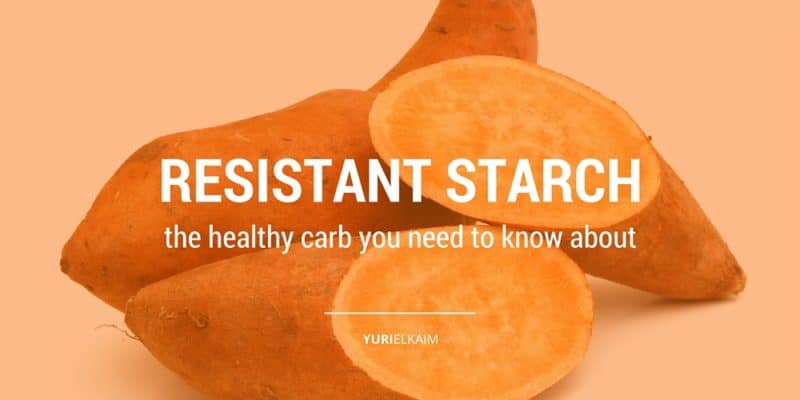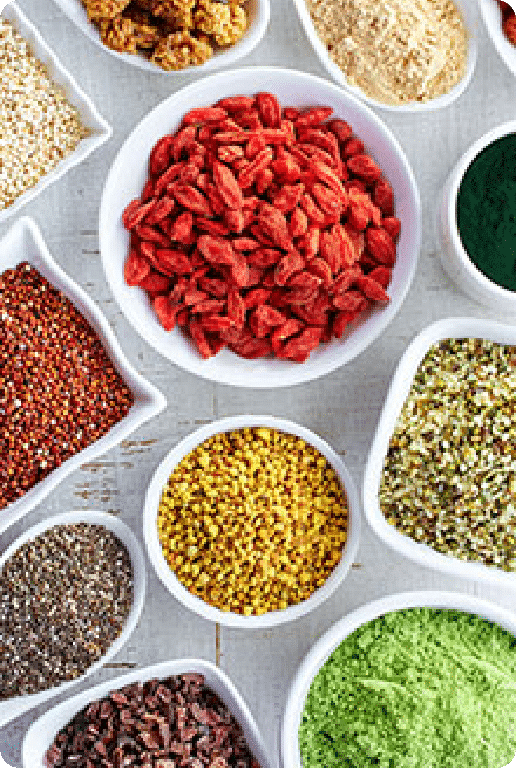With anti-carb fever gripping the fitness world in recent years, you’ve likely come to think of starch as a bad word. However, there’s one type of starch that’s actually good for you: a specific type of healthy carbs known as resistant starch.
Surprised?
As a general rule of thumb, most starchy foods are indeed packed with harmful simple carbohydrates. They’re highly processed, highly refined, and don’t offer much fiber.
You may have even heard they spike blood sugar and insulin, potentially putting you at greater risk for diabetes. It’s all true. Avoiding these kinds of starches is one of those nutrition tips that’s absolutely spot on.
Thankfully, science is beginning to see a new side to starches and it all has to do with something called resistant starch.
What is Resistant Starch?
Resistant starch is food that resists normal digestion in the small intestine.
Lined with enzymes and digestive juices designed to break foods up and absorb available nutrients, most foods are digested there.
However, some foods are resistant to the digestive power of the small intestine. These foods are resistant starches. Undigested in the small intestine, these “super” starches actually end up feeding the good bacteria in your large intestine.
To thrive, your large intestine and the bacteria within it must have proper fuel. Short-chain fatty acids—especially one called butyrate —are the preferred fuel for your internal system.
To make butyrate, the large intestine needs starch. But most starch is broken down in the small intestine. So resistant starch—starch which moves past the small intestine and into the large intestine—is vital for overall colon health because it’s one of the sources for the eventual creation of butyrate.
The Discovery of Resistant Starch
Interest into the benefits of starch and resistant starches began several decades ago. Researchers were first studying cancers of the intestines and saw that tribes and populations in East Africa had oddly low rates of bowel cancers.
This was remarkable because the diet of these populations wasn’t high in fiber, which at the time was thought to be the key to warding off bowel cancers.
[Related Article: Is the Alkaline Diet Key to Cancer Prevention?]
Instead, the East African diet was composed of very starchy foods like yams, sweet potatoes, corn and bananas. These are all foods that are relatively low in fiber and very high in the carbohydrates that most people now have an urge to stay away from.
It wasn’t just protection against bowel cancer; these East African groups also had good cardiovascular health and low rates of diabetes too!
Researchers knew there had to be something unrelated to fiber which was contributing to their remarkable health and extremely low rates of bowel cancer. The answer: an unusually high starchy food intake.
Fast forward to today, and there is now significant evidence that a diet which includes healthy starch (especially good amounts of resistant starch) can offer up serious health benefits.
The Health Benefits of Resistant Starch
Resistant starch is just too good to pass up. There are numerous health benefits for the entire body and it’s just too easy to not add to the diet. Here are a few of the most important benefits:
1. Stay Full, Longer
Similar to high-fiber or high-protein diets, resistant starch can keep you feeling full for longer. In light of the low-carb diet obsession, you may have been tempted to cut out starchy foods completely, but healthy high-starch foods can actually help you lose weight, cut cravings and boost energy.
Some studies show no effect on after-meal fullness when people eat resistant starch and others have shown a significant increase.
When you look closer at the studies, it’s clear that the difference lies in the source of the starch being used. Studies which used resistant starch from breads, corn and wheat showed NO increased fullness. However, studies using resistant starches from potatoes and potato starch DID show a significant increase in fullness after eating. (1)
The cool part about this is that you can actually enjoy white potatoes again, assuming they’re prepared properly to enhance their resistant starch. The same goes for white rice.
Here’s what you need to do to get the most bang for your buck (at least from potatoes and rice):
- Step 1: Boil the potatoes or white rice, then…
- Step 2: Let the potatoes or rice sit in the fridge for several hours to cool.
It’s the cooling that is very important as it allows the resistant starch to expand within the food. So baked potatoes, mashed potatoes, and so forth just won’t cut it. Other highly recommended options include: tubers, unripe bananas, and legumes.
2. Boost Mineral Absorption
Another exciting feature of resistant starch is how it improves absorption of minerals. Vital minerals like calcium and iron are commonly bound up in foods, making it hard for the body to absorb. Also, these are two minerals that are often deficient in a person’s diet.
When starch is fermented by gut bacteria, it creates an environment that allows minerals to be better absorbed. One study involving resistant starch showed just that—a significantly greater absorption of iron and calcium from the large intestine (2).
3. The Bathroom-Related Benefits
As if all of the above aren’t beneficial enough, resistant starch can also improve bowel function.
Bowel irregularity, constipation or diarrhea can often be improved by adding resistant starch to the diet. Remember, resistant starch isn’t broken down by the small intestine, therefore when it passes to the large intestine it serves as food for all of our good gut bacteria.
These bacteria are the key to a healthy digestion (3). They actively prevent diarrhea, cramping and help create soft bulky stools. This makes resistant starch the perfect solution for anyone who has had to set up shop in the bathroom because of dense and hard bowel movements.
4. Cancer Prevention
Possibly the most important reason to add resistant starch to your diet is for possible protection against a deadly enemy: colorectal cancer.
Today, cancers of the bowel are the 3rd most common form of cancer in the world and they’re the 2nd most deadly for men and women in the United States (4).
This is where much of the resistant-starch research has focused—on the effects of resistant starches to improve bowel health, promote good bacteria and ultimately prevent bowel cancers from forming. Results from these studies continue to come back with good news.
These studies look at makeup of gut bacteria after fermenting resistant starches. If bacteria produces abnormal proteins and acids, there’s a bad environment within the large intestine indicates an unhealthy environment. However, if bacteria make normal byproducts and less acid, the bowels are considered protected and well maintained.
Recent studies have found significantly fewer cancer-related proteins and acids in stools after eating resistant starch. There is even some research now showing resistant starch can help reverse a bad gut environment.
This is all promising, because it means there is likely a link between resistant starch consumption and the possible prevention of some colon cancers.







